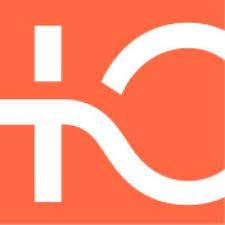
Revenue
$18.00M
2022
Funding
$88.80M
2023
Growth Rate (y/y)
64%
2022
Revenue
Based on Lifen’s early stage and employee count, Sacra estimates that Lifen’s annual recurring revenue at the end of 2022 was around $18M, up 64% from $11M at the end of 2021.
Lifen has about 180 employees today, with one-third of those (about 60) being software engineers and 20 (the next biggest category of employees) working on sales into healthcare facilities and physicians.
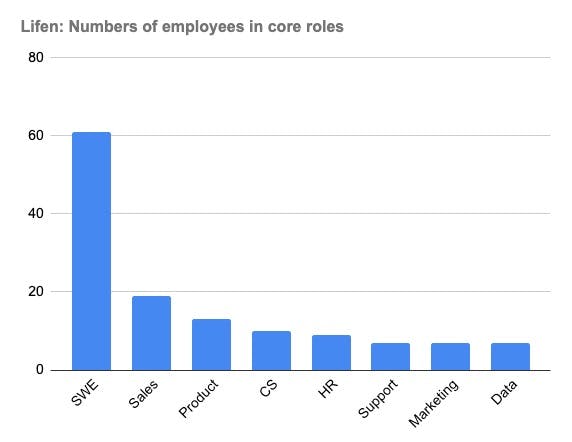
Lifen today has more than 600 partners across hospitals and primary care clinics, covering a total of 40% of the French healthcare system, while 70,000+ private practice physicians have their own Lifen accounts.
More than 5M patients have used Lifen to access their medical information since the platform’s inception in 2015.
Business Model
Lifen primarily makes money by charging physicians, medical facilities, and developers on a subscription SaaS basis to access its platform.
There are 4 notable aspects to Lifen’s business model: empowering healthcare developers, wallet share expansion, healthcare cost reduction, and geographical expansion.
Empowering healthtech developers
Healthtech startups or startups-within-big-companies building new solutions tend to have about a 12-18 month runway in which to release an initial product, start getting feedback, and iterate towards product-market fit.
The problem is that healthtech ventures face adoption and go-to-market challenges that everyday B2B SaaS companies don’t—from healthcare facility tech stacks built on non-interoperable, legacy software to regulatory and compliance challenges and healthcare-specific prerequisites.
Lifen allows them to integrate into a range of tech stacks by plugging into one API, and it also gives them a way to monitor in-app engagement via granular user metrics, allowing them to iterate and improve their products over time, as well as set up the right permissions so that each user of the app is able to see only the information that they should be seeing at any given time.
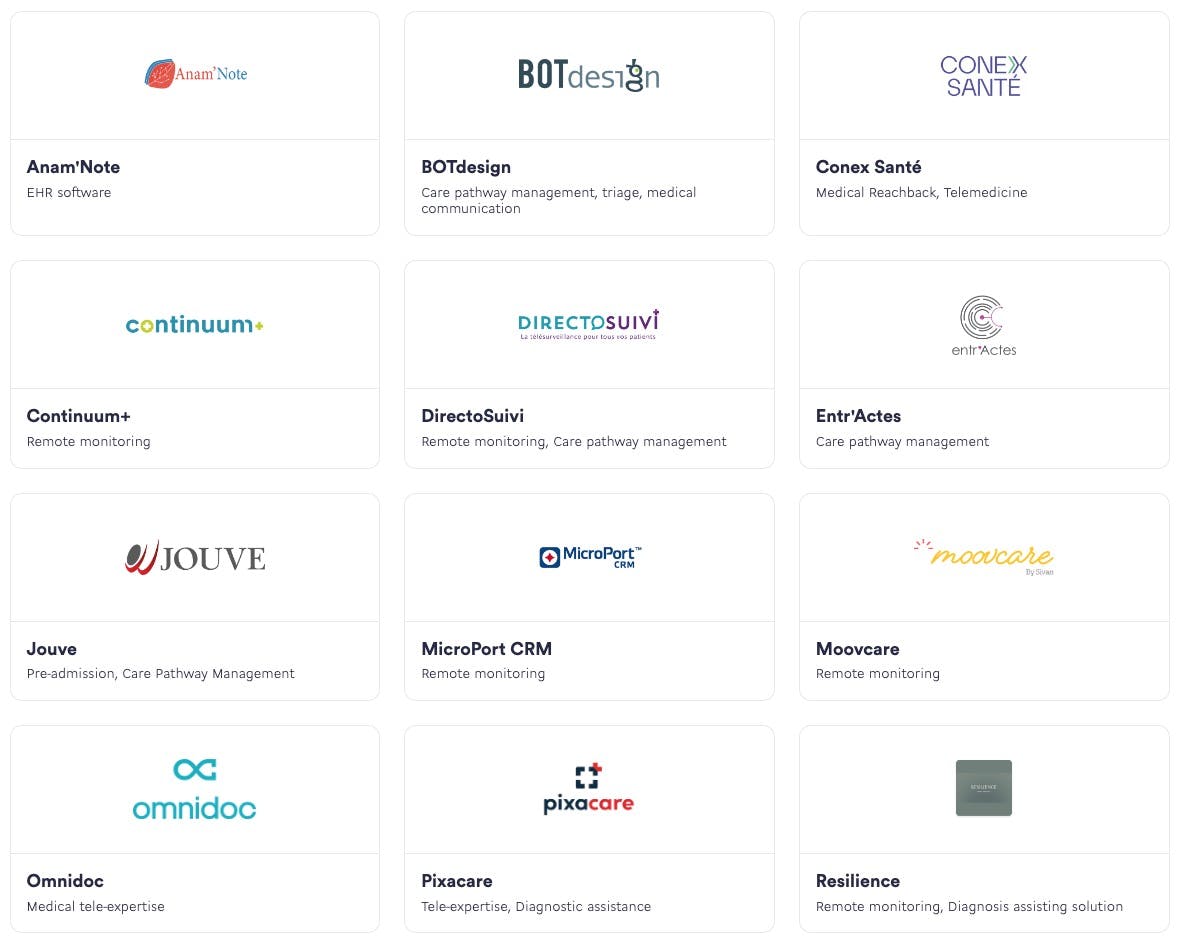
Today, 15+ third-party apps have Lifen integrations.
Wallet share expansion
Lifen began as a messaging app for healthcare professionals—a kind of DocuSign or Calendly for medical practitioners to be able to send and receive messages securely. Since then, they have launched additional products on top of that foundation to capture more use cases and expand its share of spend on healthcare and software.
One of the new products introduced was the Lifen Platform. It was designed to facilitate, speed up, and secure the roll-out of e-health solutions within healthcare information systems through a single integration.

They also launched Lifen Integration, an all-in-one solution aimed at helping physicians process documents from any source into their preferred system of record.
A product called Lifen Planning allows healthcare professionals to record their availability, generate, and publish a medical schedule in minutes. Lifen Planning comes with features that ease the collection of unavailability from all practitioners in a service and automates the allocation of duties, keeping external records automatically updated with this information as it changes.
In 2019, the cost of accessing Lifen for individual healthcare practitioners was €25 per month—new products like these allow Lifen to grow that figure towards competing with platforms like Doctolib which has an estimated estimated ARPU of $800 per user.
Healthcare facility savings
One of the key motivating reasons for hospitals to integrate with Lifen is the potential to cut down on costs amid an explosion in the cost of care across Europe and the world. According to Lifen, the average medical facility integrating with Lifen to go paperless and exchange data with 3rd-party apps sees cost savings of $545K per year per facility.
According to a report by Hospital Healthcare Europe, the total current health expenditure has increased on average of 50% in the EU in the last ten years. Major increases have been registered in EU13: Estonia (+110%), Lithuania (+107%) and Poland (+103%), while smaller but still significant increases were registered in Spain (+36%), Italy (+25%) and Portugal (+24%).
Hospitals across Europe have faced increasing difficulties in delivering high-quality and accessible healthcare to their populations, due to a variety of factors such as inflation, staffing shortages, aging populations, and the COVID-19 pandemic.
In the United States, between 2019 and 2022, overall hospital expenses increased by 17.5%, while Medicare reimbursement rose just 7.5%. Contract labor expenses rose 258% as hospitals relied more on contract labor to fill workforce gaps. Drug expenses per patient rose 19.7% as the median price for a new drug surpassed $200,000, and hospital supply expenses per patient rose 18.5% overall, and nearly 33% for ventilators, respirators, and other emergency supplies.
Geographical expansion
One of the big vectors for Lifen’s continued growth will be their continued expansion, both inside France and across the rest of Europe.
It’s in the service of this mission of expansion (and in particular, their expansion into the UK and Germany) that Lifen raised $58M from from Creadev and Luxera Capital Partners in 2021.
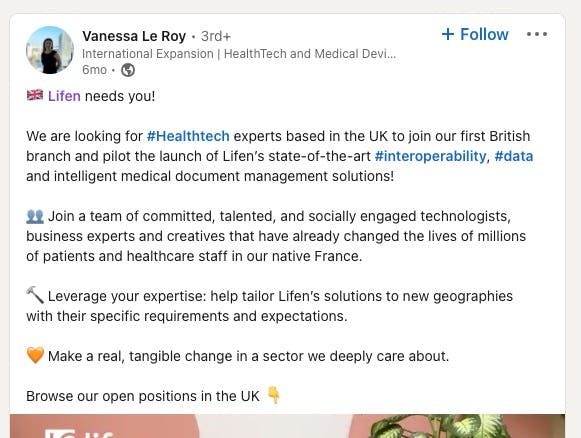
Helping along Lifen’s growth across the continent will be the fact that many European countries are facing a dire shortage of healthcare professionals, such as nurses, GPs, and specialists, and will therefore be likely to need telehealth and/or digital health solutions to fill the gap.
In France, for example, there are 9% fewer GPs than ten years ago, and in Germany, approximately 3,500 practices are without a doctor. It is estimated that unless Europe finds 230,000 more doctors, around 13.5% of its population will be without adequate healthcare coverage, especially in rural areas.
However, scaling telehealth products in Europe is not a straightforward task due to the varying regulations and healthcare maturity levels of each country. For instance, while teleconsultation fees have been covered by public insurance in the UK for years, such coverage only began in Germany in 2019.
There are also significant differences in how public healthcare funds are managed across countries with a single-payer component. While the UK manages their healthcare funding centrally through their National Health Service (NHS), healthcare spending in countries like Germany and Sweden is decentralized and managed locally by regional governments, creating complexity for platforms like Lifen looking to enter new countries.
These factors have led to most telehealth companies struggling to expand beyond one or two countries—for example, companies like Qare and Medadom have remained within France, UK’s PushDoctor and Sweden’s MinDoktor have not expanded outside their home countries even after eight years of launch. Doctolib provides a counter-example: as of 2023, it is live in 13 countries across Europe and Latin America.
Product
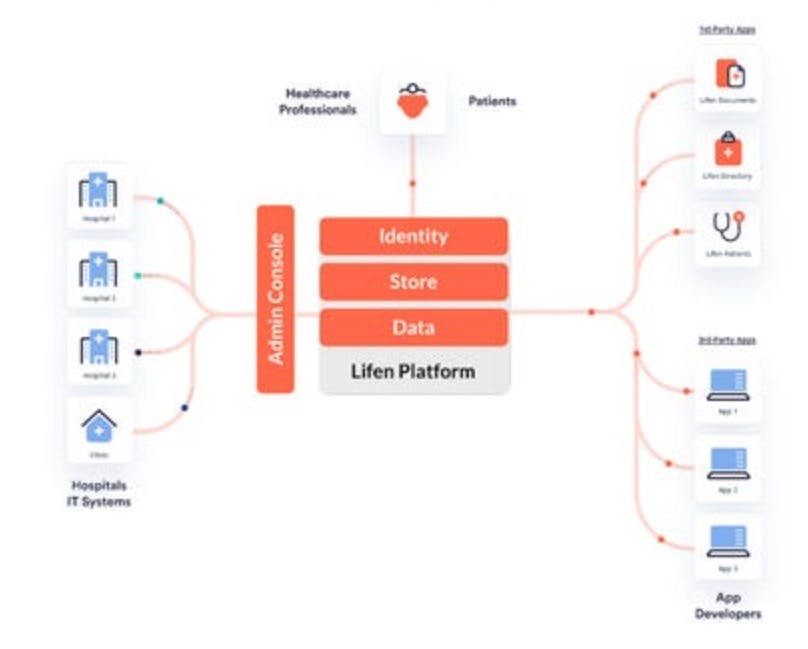
Lifen was founded in 2015. It launched as a healthcare messaging platform enabling patients to send messages to healthcare professionals through various electronic protocols like Medimail, Zepra, Apicrypt, and MS Santé and through the postal service.
Lifen’s aim was to save patients time and energy sending physical letters while saving hospitals and physicians money processing physical mail.
As of 2022, Lifen had sent 57M documents and converted 33M documents into structured data. The platform had integrations with 305 Patient Administration System (“PAS”) connectors, 176 Electronic Health Record (“EHR”) connectors, and 213 National Health Vault connectors.
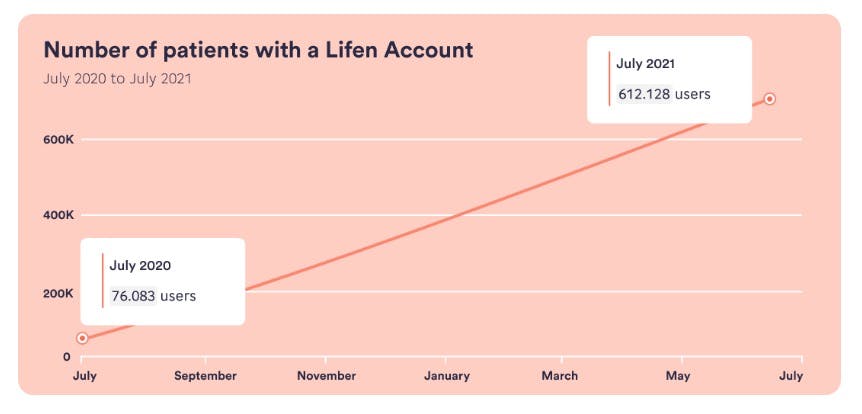
Since inception, Lifen has broadened its focus from healthcare messaging to providing 1) a platform for healthcare app developers to be able to build on top of and deploy into healthcare facilities and practitioners, and 2) an AI-powered integration tool that lets facilities automatically process PDF and paper documents into their EHR system—in sum, an “operating system” for healthcare.
Lifen Sending
Lifen Sending, Lifen’s digitized medical communications product, automates the process of integrating documents into Electronic Health Records (EHR), thus helping hospitals go paperless.
It does this by creating a direct, secure connection between Practice Management Systems (PMS) and EHRs, saving staff—on average—1 hour per day.
Lifen Sending has been trained on more than 26 million medical documents, which has equipped it with the capability to detect and extract key information from documents via digital optical character recognition (OCR), such as patient traits, document type, stay information, sender and recipient information, and pseudonymised sensitive information.
Patients using Lifen receive email notifications about recent visits to the doctor and any updates to their medical records, and they can access their documents directly from their web browser.
Lifen Sending also uses machine learning algorithms to transform medical documents into structured data, which aids in bridging the interoperability gap in medical data management. The platform can also identify data inconsistencies in EHR output, format this data, and push cleaned data back to the EHR where it can then be accessed externally via APIs.
Lifen Platform

Lifen has built connectors—SFTP, HL7, CDA-r2, FHIR, etc.—with 700 different Clinical Information Systems, Practice Management SaaS, and Electronic Patient/Medical Records Software, enabling developers to integrate once with a Lifen-built FHIR API connector and instantly, vastly open up their go-to-market. Once integrated and permission is granted, companies get full read and write access to all of their patients’ details.
Among its services, the Lifen Platform offers:
App Distribution: The Lifen App Store provides access to a catalog of partner applications, and it also offers a platform for solution providers to distribute their solutions easily.
User Management: An identity management suite covers all identification and authorization scenarios specific to the health space, including Single Sign-On (SSO). It offers built-in, modular user flows for Know Your Customer (KYC) functionality (identity verification) and Two-Factor Authentication (2FA).
Data Connection: A single connector allows organizations to implement all of the applications available in the Lifen App Store, reducing cost and the duration of integrations. Similarly, vendors can implement their solutions across all Lifen user organizations with a single integration.
The platform serves both care providers and digital health solutions. For care providers, the platform enhances the interoperability of their IT systems, improving their flexibility, security, and sustainability. This is crucial as healthcare organizations often struggle to fully utilize their existing IT systems due to poor interoperability.
On the other hand, for digital health solutions, the Lifen Platform provides a solid technology foundation that supports the journey from market entry to scaling, including international expansion. This allows solution developers to focus on improving their products and creating new features that match real-world needs.
Lifen Integration
Lifen Integration allows healthcare providers to easily ingest medical documents from all forms—PDF and paper documents included—and process them into their facility’s EHR system.
The use of AI technology in Lifen Integration helps to automate the extraction of the key pieces of information from medical documents as well as reduce the frequency of errors that can occur with manual data entry, ensuring a higher level of data accuracy but also lessening staff burnout from repetitive tasks.
Lifen Integration creates a single, reliable source for medical records, helping to create a more accurate representation of a patient's medical history, which in turn contributes to the quality of patient care.
Market
Lifen, as a “universal API” for healthtech products that helps both physicians and developers deploy and integrate medical records with novel applications, both fuels the growth of telehealth and digital health and benefits from it.
Lifen also benefits from secular trends we’re seeing across Europe—namely, the surge in wait times and reductions in staff across national health services on the continent. As healthcare services are strained and the 65+ year old population continues to grow, companies indexed on digital health will see increased demand for their services.
That said, Lifen will face competition—particularly from other regional telehealth and digital health players building in other countries throughout Europe.
The explosion of medical data
The healthcare industry today accoutns for roughly 30% of the world's total volume. This vast amount of data is growing at an extraordinary rate, increasing by 40% annually. Projections indicate that by 2025, healthcare data will make up 36% of the world's total data volume.
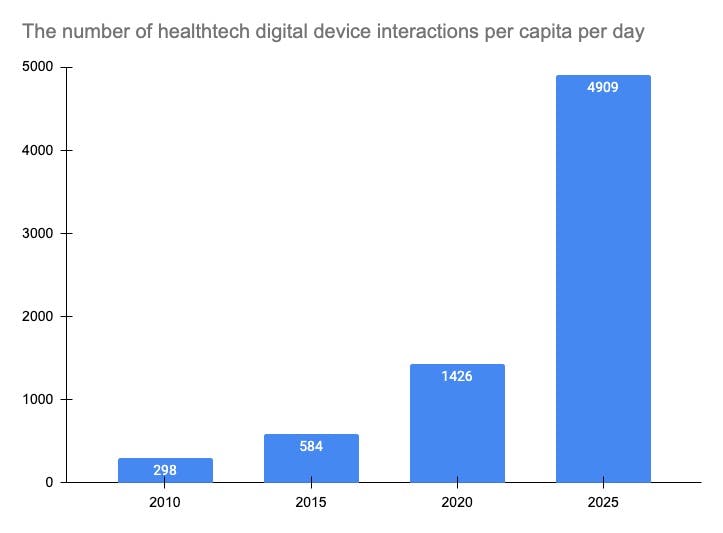
Our number of daily interactions with medical devices is skyrocketing, from shy of 600 in 2015 to an estimated 4,900+ by 2025.
The rise of the Internet of Medical Things (IoMT) is a significant driver of this growth. This network of interconnected health and medical devices is generating data at an unprecedented rate. In 2020, the average person interacted with digital devices over 1,400 times each day. By 2025, this figure is expected to skyrocket to around 5,000 interactions daily.
Despite this wealth of data, a significant portion of it remains unstructured—around 80%—making it challenging to analyze and derive insights. Unstructured data in healthcare can range from free-text notes in electronic health records to medical images, genomic data, and data from wearable devices.
Lifen's platform gives physicians a single system of record that can integrate all of a patient’s data and medical history from various sources, including lab results, imaging studies, clinical notes, and other health records, regardless of the systems in which they were initially created or stored.
The physician bottleneck
In 1980, clinicians needed to consider about 10 facts per decision they made in treatment. Today, a single patient’s medical record can contain as many as 1,000 relevant facts or more. Given that the human mind can only process around five facts at once, there’s an innate discrepancy between the amount of information physicians deal with and their ability to make sense of it.
Furthermore, by 2030, it's estimated that there will be a shortage of over 15 million health workers worldwide. This emphasizes the need for efficient, effective tools to manage and interpret the vast and growing body of healthcare data, which is where integration via platforms like Lifen can be powerful.
Lifen enables the centralizing of all health data into a single system of record, making it readily available for analysis and interpretation, supporting healthcare professionals in making informed decisions and ultimately improving their ability to give out patient care.
Europe’s aging population
The percentage of people over 65 in Europe grew from 15.8% in 2001 to 20.8% in 2021. This trend is expected to continue, with 30% of the European population expected to be above 65 in the next 20 years, adding 32M people with high healthcare needs to the European population. Equally importantly, three in five people 65 years old or older believe they don't have good health, compared to just one in five for less than 65 years.
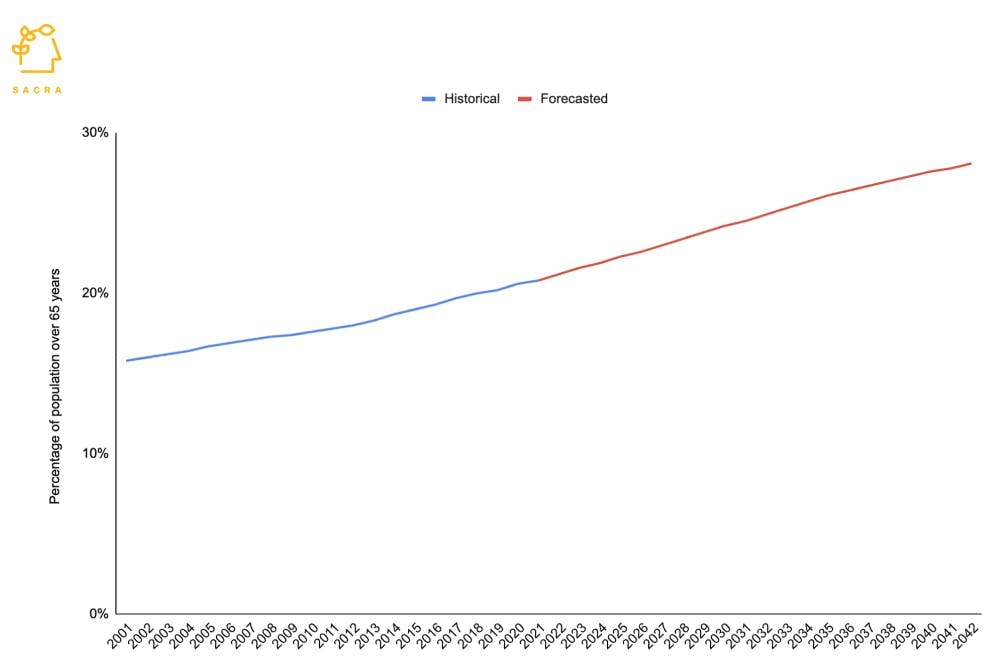
In the next 20 years, ~30% of Europe's population will be more than 65 years.

3x people over 65 believe they are not well, compared to people under 65.
An aging population can serve as a tailwind for telehealth and digital health apps—and thus for companies like Lifen enabling and capitalizing on their adoption—for several reasons:
Chronic disease management: As people age, they are more likely to develop chronic conditions like heart disease, diabetes, and arthritis. Telehealth can help manage these conditions by allowing for regular check-ins, medication reminders, and health monitoring without the need for frequent physical visits to healthcare providers.
More frequent monitoring: Aging populations often require more frequent health monitoring. Digital health apps can provide constant health monitoring and send real-time data to healthcare providers, enabling timely interventions when necessary.
Support for caregivers: Digital health tools can also provide valuable support for caregivers, who often play a crucial role in managing the health of aging individuals. These tools can provide caregivers with necessary medical information, reminders about medication schedules, and a direct line of communication with healthcare providers.
Blockchain solutions
Medicalchain, founded by Dr. Abdullah Albeyatti and Mo Tayeb in early 2016 in London, is working on bringing blockchain technology to bear on storing health records on a distributed ledger, ensuring data integrity and transparency. Medicalchain also provides a platform for developers to build applications that leverage the medical data of users who opt in to share their records.

In a blockchain EHR model, immutability and transparency are guaranteed by smart contracts between hospitals, doctors, insurers, laboratories, and pharmaceutical companies.
Medicalchain is one of the leading blockchain startups in the healthcare industry, with partnerships with various organisations such as MyClinic.com, The Groves Medical Group, Mayo Clinic and more. Medicalchain is also developing its own token, MedToken, which will be used to power the platform and reward users for sharing their data.
There are a few key reasons why medical records have emerged as one of the most popular targets for blockchain builders looking for real-world problems that could use cryptographic solutions:
Security: Unlike traditional systems, where medical data is stored in centralized databases, blockchain offers a decentralized approach. This means that the data isn't stored in a single location that could be vulnerable to failures or breaches. Instead, the data is distributed across multiple nodes (computers) participating in the blockchain network, adding a layer of resilience and security.
Blockchain uses advanced cryptographic techniques to ensure that the data is secure and tamper-proof. Once a block of data is added to the blockchain, it cannot be changed or deleted, which ensures the integrity and auditability of the medical records. Moreover, the patient could control who has access to their medical records, enhancing privacy.
Interoperability: One of the major challenges in the current healthcare system is the lack of interoperability between different healthcare providers. A patient's medical records may be scattered across various healthcare institutions, making it difficult to have a complete, unified patient health record. Blockchain, with its ability to securely link blocks of information, can help create a comprehensive and up-to-date health record for patients that can be accessed (with proper permissions) by any healthcare provider, improving the continuity of care.
Traceability: Blockchain can provide an immutable, time-stamped history of all medical transactions, which can be incredibly valuable for audit trails, tracking the chain of custody for a drug, or verifying the accuracy of information.
By addressing these issues, blockchain has the potential to greatly improve the way medical records are handled, enhancing patient care, data security, and efficiency in the healthcare system. However, it's important to note that the use of blockchain in healthcare is still in its early stages, and there are many regulatory, technical, and practical challenges that need to be overcome for widespread adoption.
Country-by-country dynamics
United States

Klara, a healthcare communication company based in New York, has developed a messaging platform that enables medical teams to consolidate all their patient-related communications.
Klara was founded in early 2014 by Simon Bolz and Dr. Simon Lorenz as a consumer-facing telemedicine app—today, its applications are used by hundreds of health systems across the United States, from solo practices and modern pharmacy companies to large medical groups and hospitals, like Athena Health, NextGen Healthcare, AdvancedMD and Veradigm.
France
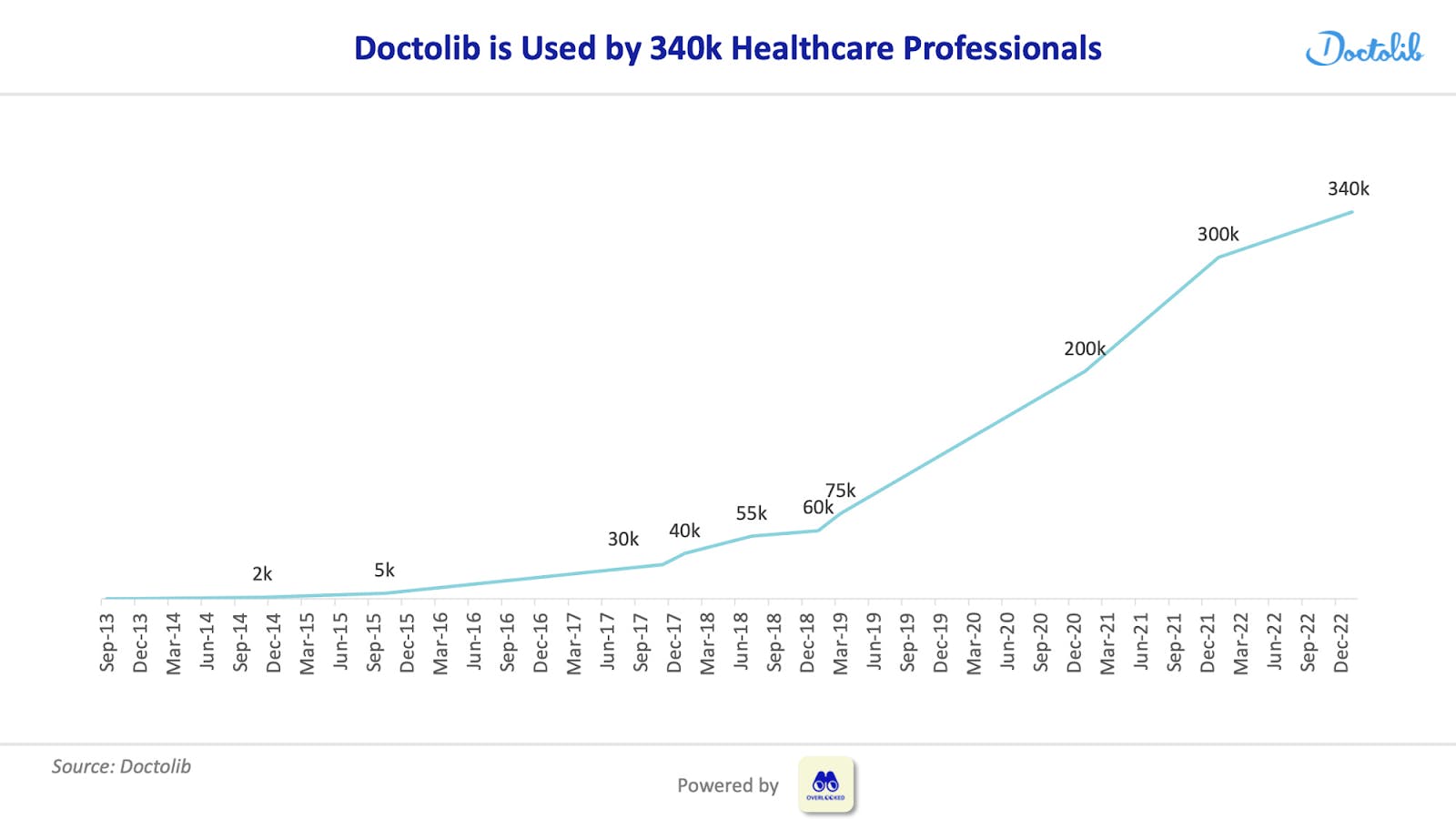
Doctolib, founded in 2013, is a major player in the healthcare technology sector in Europe—in February, it became France’s most highly valued startup at $6.4B.
The company, which has more than 2,500 employees on their team, offers a SaaS suite of products for both healthcare professionals and patients, from appointment scheduling to sharing medical documents securely.
Doctolib's platform is used by more than 300,000 health professionals and 250 public hospitals, and has served 60 million people across France, Germany, and Italy.
Doctolib also includes features such as an online waiting room and automatic reminders, making it easier for healthcare providers to manage their practices and for patients to stay on top of their healthcare needs. In 2020, the company expanded its services by launching a telemedicine service.
UK
AccuRx is a British software company that develops communication tools for healthcare professionals and patients. The company was founded in 2016 and has grown rapidly since then, reaching more than 90% of primary care clinics in England by 2020.
AccuRx's main product is Chain SMS, a messaging program that allows doctors to send text messages and video calls to patients, as well as share information with other clinicians. Chain SMS can integrate with some software used in GP surgeries, such as SystmOne and EMIS Health.
AccuRx also launched Record View in 2022, a system that lets clinicians view a summary of a patient's GP medical record with their permission. AccuRx aims to make patients healthier and healthcare staff happier by improving communication and collaboration in the health sector.
Spain
Savana, a Spanish-based company founded in 2014, specializes in using AI to provide physicians with real-time access to patient population information by efficiently analyzing and converting clinical documents, even unstructured information, into actionable knowledge
Currently, Savana's platform is operational in more than 40 hospitals in Spain and one hospital in Chile. With its existing coverage, the platform serves a population of over 9 million citizens. The platform's efficacy is demonstrated by processing over 400 million electronic medical records in multiple languages, including English, Spanish, German, and French. Additionally, Savana collaborates with leading global pharmaceutical companies and over a hundred healthcare facilities.
TAM Expansion
While the last few post-COVID years have rolled back many of the pandemic-era explosions in non-fungible tokens and the “creator economy”, a select few changes—the rise of telehealth being one of the key ones—has been shown to be an enduring trend.
As a company working on building the technological underpinning to make digital health solutions faster and cheaper to build, Lifen is directly indexed on the rise of telehealth—and any kind of long-distance, digitally-based health care—as a sector.
From there, Lifen has numerous avenues for further expansion: from the Twilio-like motion of building a platform of workflow products for patients and doctors on top of their existing universal API, to geographical expansion across Europe and the rest of the world, to the potential of incorporating artificial intelligence and machine learning into their existing product line.
The rise of telehealth
Telehealth has been steadily gaining popularity in Europe as a way to improve access to healthcare over the last several years, especially for patients with chronic diseases, medication management needs, or those living in remote areas. According to a survey conducted in Europe in 2020, 54 percent of healthcare providers indicated they have telehealth services in use, while a further 24 percent of health providers have plans to use it in future.

During COVID, the number of hours spent on doctors’ apps rose—from 11.7M in Q4 2019 to 81M in Q3 2021.
The telemedicine market size in Germany was $3.21B in 2021, up by 20% from the previous year. Furthermore, the telemedicine consultation market size in France reached €1.5B Euros in 2021, up 300% increase from 2019. The average number of teleconsultations per physician in France also rose from 52 in 2020 to 105 in 2021.
At the same time—and helping to power this trend towards telehealth—the cost of delivering healthcare services in Europe has also been on an upward trend. Total healthcare expenditures in the European Union hit €1.8T Euros in 2021. As a consequence, the EU itself is a proponent of telehealth and is moving to push such initiatives forward, having already established a legal framework for cross-border exchange of patients' health data and electronic prescriptions and also funding research and innovation projects on telehealth through its Horizon 2020 program.
Lifen, with its focus on making hospitals paperless and integrating documents into electronic health records (EHRs) using proprietary AI technology, is in line with this trend in a few key ways:
Development: By helping healthtech developers roll out new e-health solutions, Lifen can speed up the digitization process, making healthcare more efficient and accessible.
Interoperability: Lifen's platform and API facilitate interoperability by allowing different systems to communicate and exchange information. This enhances the effectiveness of telehealth solutions by ensuring that patient data can be accessed and shared across various platforms and providers.
Expansion: As telehealth services expand across geographical boundaries, healthtech companies need platforms that can handle diverse healthcare regulations and systems. Lifen’s platform can be a key asset in this regard, enabling developers to roll out solutions that are adaptable to different healthcare systems.
From universal API to platform
Lifen has the opportunity to build upwards from their existing network of patients, physicians and healthcare facilities and go from a universal API or communication enabler between different healthcare systems to a comprehensive platform and workflow tool for numerous different healthtech jobs-to-be-done.
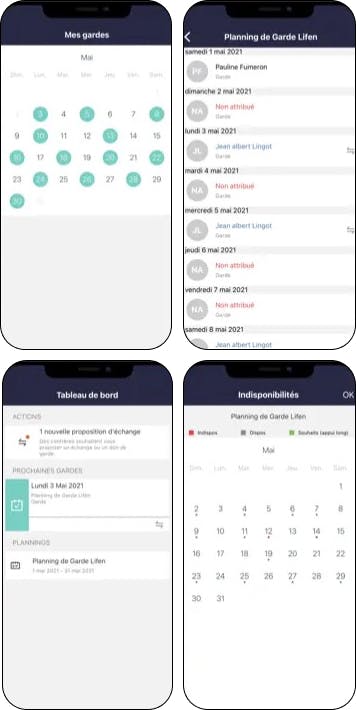
Today, Lifen has a scheduling app that allows physicians to manage their on-call schedules for better coordination.
The core idea here is that Lifen has the potential to utilize its network of patients, physicians, and medical facilities, along with its existing integration into health records, to improve on and expand the types of telehealth applications currently available.
Virtual consultations: While Lifen currently facilitates communication between healthcare providers, it could add a feature for teleconsultations with a more integrated view of a patient's medical history by virtue of its access to their health records and to their other apps, improving the quality of care.
Appointment scheduling: A platform similar to Zocdoc that allows patients to book, reschedule, and cancel appointments with physicians could be a valuable addition. This would streamline the process for both patients and healthcare providers—and it could e.g. consider both healthcare professional availability and patient needs, making it more efficient.
Remote patient monitoring: Tools for remote patient monitoring, such as apps or devices that track vitals or symptoms, could improve chronic disease management. The data collected could be automatically shared with healthcare providers, as well as feed back into a patient's health record in real-time, enhancing the usefulness of telehealth visits.
Mental health services: Offering digital mental health services such as therapy or counseling sessions could cater to the increasing demand for such services. This could range from AI chatbots for preliminary mental health screening to scheduling appointments with mental health professionals, each of which could leverage a patient’s health data to personalize treatment plans.
Health and wellness: Tools or apps focusing on preventive care, like exercise tracking, diet planning, or stress management, could be beneficial. These resources could be personalized based on individual health data.
In essence, Lifen would be moving from the back-end to the front-end of healthcare IT, positioning itself not just as a facilitator of communication between disparate systems, but as a provider of user-facing applications that improve patient care and healthcare operations. This could significantly increase Lifen's value proposition to both healthcare providers and patients, and could open up new revenue streams and opportunities for growth.
Artificial intelligence
The fast pace of development in AI and machine learning presents a number of ways Lifen could deepen its product offering, grow revenue, and expand its TAM:
Improved accuracy: As the AI algorithms used by Lifen continue to learn and improve, they will become even more accurate in extracting and structuring data from health documents. This could mean less need for human intervention, which would further increase efficiency and reduce the risk of errors.
As NLP technology continues to improve, Lifen could utilize it to better understand the context and nuances in health data. This could help in accurately extracting more complex information from health documents, such as determining the significance of symptoms described in a doctor's notes, or understanding the progression of a patient's disease based on their health records.
Predictive analytics: With advancements in AI, Lifen could potentially move into predictive analytics, using the wealth of structured health data they have to predict health outcomes or disease progression. This could provide valuable insights for healthcare providers and potentially improve patient care.
Personalized healthcare: AI advancements could enable Lifen to offer more personalized healthcare solutions. This could include customized treatment plans based on a patient's specific health data, or personalized health monitoring and alerts.
Future AI advancements could enable automated decision-making based on the health data processed by Lifen. For example, AI could potentially suggest treatment options or flag high-risk patients based on their health records.
It's important to note, however, that while AI presents certain opportunities, it also comes with challenges—like ensuring the privacy and security of patient data and dealing with possible ethical implications of AI decision-making in healthcare.
Risks
Regulatory changes: Changes in healthcare laws, data privacy regulations, and guidelines around AI use could impact how Lifen operates or limit its ability to provide certain services. For example, stricter data privacy laws could make it more challenging for Lifen to collect and process health data.
Country-by-country differences: Every country has its own set of regulations concerning digital health records, from how they’re organized and to what extent they’re digitized, how they’re secured, and to what degree their platforms are interoperable. Lifen would need to ensure its offering is compliant and compatible with the way each country works, which could be a big obstacle to their continued growth across Europe.
Fundraising
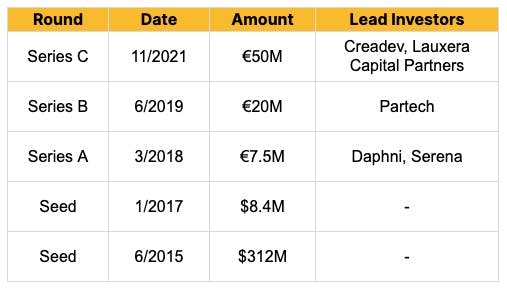




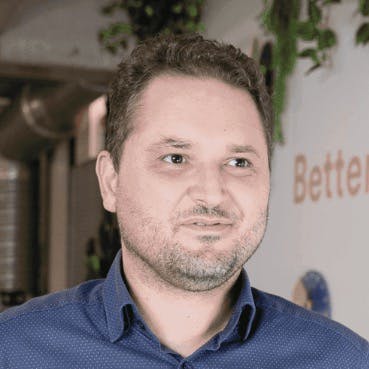



News
DISCLAIMERS
This report is for information purposes only and is not to be used or considered as an offer or the solicitation of an offer to sell or to buy or subscribe for securities or other financial instruments. Nothing in this report constitutes investment, legal, accounting or tax advice or a representation that any investment or strategy is suitable or appropriate to your individual circumstances or otherwise constitutes a personal trade recommendation to you.
This research report has been prepared solely by Sacra and should not be considered a product of any person or entity that makes such report available, if any.
Information and opinions presented in the sections of the report were obtained or derived from sources Sacra believes are reliable, but Sacra makes no representation as to their accuracy or completeness. Past performance should not be taken as an indication or guarantee of future performance, and no representation or warranty, express or implied, is made regarding future performance. Information, opinions and estimates contained in this report reflect a determination at its original date of publication by Sacra and are subject to change without notice.
Sacra accepts no liability for loss arising from the use of the material presented in this report, except that this exclusion of liability does not apply to the extent that liability arises under specific statutes or regulations applicable to Sacra. Sacra may have issued, and may in the future issue, other reports that are inconsistent with, and reach different conclusions from, the information presented in this report. Those reports reflect different assumptions, views and analytical methods of the analysts who prepared them and Sacra is under no obligation to ensure that such other reports are brought to the attention of any recipient of this report.
All rights reserved. All material presented in this report, unless specifically indicated otherwise is under copyright to Sacra. Sacra reserves any and all intellectual property rights in the report. All trademarks, service marks and logos used in this report are trademarks or service marks or registered trademarks or service marks of Sacra. Any modification, copying, displaying, distributing, transmitting, publishing, licensing, creating derivative works from, or selling any report is strictly prohibited. None of the material, nor its content, nor any copy of it, may be altered in any way, transmitted to, copied or distributed to any other party, without the prior express written permission of Sacra. Any unauthorized duplication, redistribution or disclosure of this report will result in prosecution.